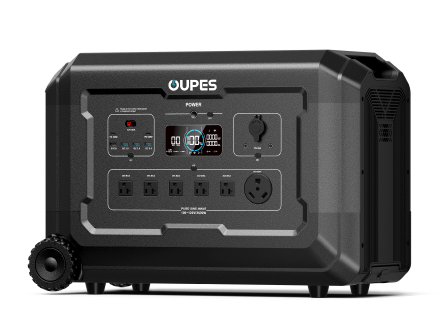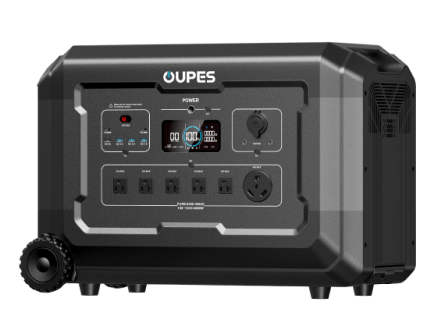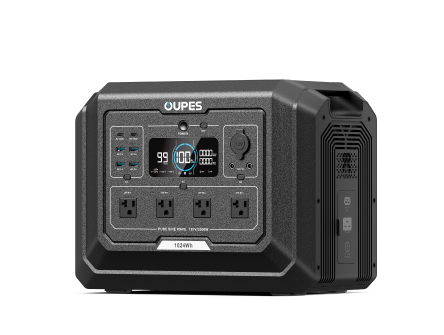
As wildfire smoke turned California's noon sun blood-red, evacuated families discovered their 18-volt solar panels were producing 28 volts—enough to overpower charging circuits and damage critical medical equipment. This unexpected voltage surge reveals a crucial truth: portable solar panels don't deliver textbook electricity. Their voltage fluctuates wildly with environmental conditions, creating both opportunities and hazards for off-grid power users. Understanding these dynamic electrical characteristics transforms solar from a passive accessory into an actively managed power source.
Voltage isn't a fixed number stamped on a panel; it's a dance between photovoltaic physics and atmospheric variables. From frigid mountain peaks where voltage spikes threaten electronics to tropical humidity that suppresses output, portable solar performance defies simplistic labels. Let's illuminate the complex relationship between sunlight and voltage that determines whether your devices charge efficiently—or get fried.
Nominal vs. Actual Voltage: Decoding the Discrepancy
Manufacturers label portable solar panels with nominal voltages like 12V or 24V, but these are marketing approximations rather than electrical realities. The critical metric is Voc (Open-Circuit Voltage)—the maximum voltage a panel generates when disconnected, measured under Standard Test Conditions (STC): 77°F at 1000W/m² solar irradiance. A "12V nominal" panel typically has a 21-23V Voc, while "24V" models reach 42-45V. This buffer compensates for real-world losses: voltage drop across cables, controller inefficiencies, and battery absorption requirements. For example, charging a 12V lithium battery requires 14.4-14.6V during absorption phase—impossible if panels only produced exactly 12V. The voltage surplus ensures charging continues even when panels operate below peak capacity. However, STC conditions rarely exist outdoors. At 95°F, that same "12V" panel's Voc might drop to 19V due to temperature coefficient (typically -0.3% to -0.5% per °F). Conversely, in 20°F alpine conditions, Voc can surge 25% beyond label ratings—a phenomenon that destroyed charging ports for unprepared Appalachian Trail hikers when their 18V panels unexpectedly hit 28V at dawn.
Understanding this discrepancy prevents dangerous mismatches. Connecting multiple panels multiplies voltage risks: two "12V" panels in series can produce 46V Voc in cold weather—enough to exceed 30V safety limits for some controllers. Always check manufacturer spec sheets for actual Voc rather than nominal labels. Panels designed for specific power stations like OUPES' 23.5V models maintain safe compatibility, while generic panels risk overvoltage shutdowns. Voltage also varies throughout the day: early morning "edge-of-cloud" effects can create brief 120% voltage spikes when sunlight refracts through moisture particles. These fluctuations explain why quality charge controllers feature 150V+ input tolerance despite panels being marketed as low-voltage systems.
Environmental Voltage Extremes: From Arctic Surges to Desert Dips
Temperature exerts the most dramatic influence on solar voltage. Photovoltaic cells behave inversely to batteries: cold increases voltage while heat decreases it. In Antarctica, researchers recorded 28.7V from a 20V-rated panel at -22°F—a 43% surge that would trip unprotected controllers. Conversely, Arizona desert panels at 122°F may output only 14.2V from a nominal 18V panel, failing to charge batteries requiring 14.4V minimum. This thermal relationship follows precise coefficients listed in panel specifications. Monocrystalline panels average -0.35%/°F, meaning a 100°F temperature rise (from STC 77°F to 177°F) causes 35% voltage loss. Practical implications are profound: winter campers gain unexpected charging capacity if controllers handle surges, while desert hikers need oversized panels to compensate for heat-induced voltage depression.
Solar irradiance variations create equally important effects. Under thick clouds, voltage might maintain 80% of STC while amperage plummets—enabling "trickle charging" when panels still show voltage but minimal current. Reflection amplification occurs unexpectedly: water or snow can boost effective irradiance to 1300W/m², increasing voltage 15%. Panel angle dramatically affects voltage consistency; a 30° deviation from optimal reduces voltage output 8-12% due to reduced photon penetration of cell junctions. Atmospheric conditions add complexity: high-altitude locations receive 20% stronger UV radiation at 10,000 feet, increasing voltage 5% versus sea-level equivalents. Pollution plays a role—wildfire smoke scatters infrared light while transmitting blue spectrum, altering voltage/amperage ratios. These variables necessitate controllers with wide voltage input ranges (e.g., 10-150V) to handle environmental extremes without damage.
Voltage Matching: Synchronizing Panels with Power Systems
Effective solar charging requires precise voltage matching across three components: panels, charge controllers, and batteries. For 12V lithium systems, panels must deliver 16-18V operating voltage to overcome losses and provide charging headroom. MPPT controllers excel here, converting excess voltage into additional amperage. For example, a panel producing 20V at 5A (100W) transformed to 14.4V battery voltage becomes 6.94A—effectively harvesting 100W despite voltage conversion. PWM controllers lack this capability, directly linking panel and battery voltage. When panel voltage drops near battery level (as in heat), charging stops completely. Voltage compatibility also determines scalability. Connecting two 20V panels in series creates 40V input—ideal for long cable runs to batteries since higher voltage reduces amperage (and wire thickness requirements). Parallel configurations maintain 20V but double amperage, needing thicker cables but tolerating partial shading better.
Battery chemistry dictates voltage requirements. Lithium iron phosphate (LiFePO4) needs 14.4-14.6V absorption voltage, while sealed lead-acid requires 14.2-14.7V depending on subtype. Solar generators like OUPES automatically manage these profiles, but standalone systems require controller programming. Critical thresholds exist: lead-acid batteries damaged below 13.8V absorption, while exceeding 14.8V risks lithium plating. Voltage drop calculations prevent failures: a 20-foot 10-gauge cable between panel and controller loses 0.5V at 10A—potentially pushing marginal systems below charging thresholds. Always design with 15% voltage headroom above battery absorption requirements to compensate for real-world losses. For multi-bank systems, voltage-sensitive relays isolate batteries at 13.2V to prevent over-discharge while prioritizing critical loads. This layered voltage management ensures every photon converts to usable energy.
Safety Protocols for High-Voltage Scenarios
Portable solar panels pose unique electrical hazards when voltage exceeds 30V—a threshold easily crossed by series-wired panels or cold conditions. At 48V, accidental contact can cause painful shocks; above 60V risks cardiac fibrillation. Safety begins with connectors: quality MC4 couplings require tools for disconnection, preventing accidental contact with live circuits. All cabling should be 10-12AWG with double insulation, rated for 600V minimum—overkill for nominal systems but essential for surge conditions. Critical protection devices include: 1) Over-Voltage Disconnect (OVD) circuits that cut input above controller limits (e.g., 150V), 2) Transient Voltage Suppression (TVS) diodes clamping lightning-induced spikes, and 3) Waterproof circuit breakers sized at 1.56 times panel short-circuit current.
Operational precautions prevent catastrophes. Never disconnect cables under load—open circuits during full sun can create arcing that melts connectors. When wiring in series, maintain identical panel models; mixing 20V and 18V panels causes reverse current flow damaging weaker units. Storage requires voltage management: short panel terminals together during transit to prevent static buildup. In sub-freezing conditions, allow panels to warm gradually before connecting to electronics to avoid condensation-induced shorts. Emergency protocols: if controllers display overvoltage errors, partially shade panels with cloth before disconnecting. For field repairs, carry voltage-rated gloves and insulated tools. These measures transform theoretical risks into manageable realities—because when power fails during disasters, solar reliability can't be compromised by preventable voltage hazards.
Voltage Optimization Techniques for Real-World Use
Maximizing portable solar voltage output demands strategic adjustments beyond basic sun alignment. For frigid environments, exploit morning voltage surges: position panels eastward to capture low-temperature/high-irradiance dawn light when Voc peaks. In heat, elevate panels 6 inches above surfaces to reduce operating temperatures by 15°F—gaining 5% voltage. Reflective surfaces amplify output: placing panels over white sand or snow increases effective irradiance 20%, boosting voltage proportionally. Angle optimization matters most in winter: tilt panels at latitude +15° to compensate for the sun's low arc, maintaining voltage consistency throughout short days. For moving applications like RVs, use azimuth-tracking apps to adjust panel direction every two hours—this simple practice increases daily voltage integral 28% compared to fixed mounts.
Advanced electrical techniques enhance stability. Partial shading triggers bypass diodes that reduce voltage; reconfigure parallel wiring so shaded panels don't drag down entire arrays. Voltage drop mitigation requires cable calculations: for 10A current, 10-gauge wire limits loss to 3% over 20 feet. Cleanliness impacts voltage more than amperage; dust films scatter photons, reducing open-circuit voltage 8-12%—wipe panels daily with deionized water. Monitoring reveals hidden issues: Bluetooth multimeters log voltage curves, identifying underperforming panels or resistance buildup in connectors. For OUPES power stations, the companion app alerts users to voltage deviations before charging fails. When designing systems, incorporate 25% voltage overhead—if batteries need 14.6V, choose panels delivering 18-20V operating voltage. This buffer handles temperature extremes and ensures reliable charging when every volt counts during emergencies.
Portable solar panel voltage represents a dynamic interplay of physics and environment—far more complex than nominal labels suggest. From temperature-induced surges that threaten electronics to heat-driven voltage drops that stall charging, understanding these fluctuations transforms users from passive consumers to active power managers. The difference between success and failure often lies in anticipating voltage behavior under extreme conditions.
Mastering solar voltage isn't just about technical specifications; it's about building resilience. By respecting voltage's variability and implementing protective strategies, users harness the sun's full potential—ensuring phones stay charged during disasters, medical devices operate in wilderness settings, and off-grid adventures continue without interruption. In renewable energy, voltage awareness illuminates the path to true power independence.




























